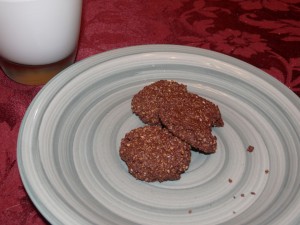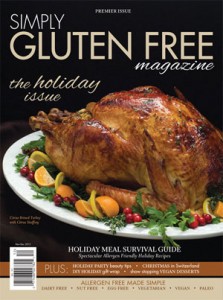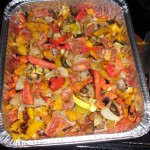UPDATE: THANKSGIVING 2013 NEWSLETTER HERE WITH UPDATED LINKS/INFO
It takes a little planning ahead to guarantee a great Thanksgiving. In many ways, it’s easier if you’re hosting, because you know what you can and can’t have. Most people hate to impose on their hosts, but it’s easier on you AND your host to ask beforehand than sit through a four-hour meal and watch others eat. Remember, nothing is more important that staying safe!
Turkey:
Though it’s always good to check, the good news is that all plain fresh turkey is naturally gluten free. However, self-basting turkeys usually contain gluten. Most gravy packets are a problem, too. As of 2011, ALL of the companies I called did have gluten-free turkeys, except Tofurky, which has gluten. Check out my gluten-free turkey list for 2011, which has manufacturer contact info.
If you’re not hosting Thanksgiving at your house, talk to your host as soon as you can. You’ll need to talk about:
* Broth used for basting
* Seasonings
* Stuffing in the turkey
* Cross contamination
Vegetarian/vegan options:
Okay, so Tofurkey is off the table. Here are great roundups with ideas for main meals. Most of the other sides here are already vegetarian.
Gluten-Free Goddess’ Roundup
About.com’s roundup
Gravy
Almost all regular canned gravy and gravy packets are not gluten-free. Gluten-free gravy is available online, and Trader Joe’s sells some now. Also, it’s pretty easy to make a simple gravy with gluten-free broth and cornstarch instead of wheat (and if corn is a problem for you, arrowroot can be substituted 1:1 instead).
Herb Gravy From Elana’s Pantry
Gravy using Cornstarch from Simply Recipes or see this link for recipes.
Side dishes
There are lots of good o ptions here. Green bean casserole, baked yams, cranberry relish, gelatin salads, butternut squash soup, mashed potatoes, roasted veggies, applesauce…all of these things are easy to adapt to food restrictions, and they’re healthy and delicious to boot.
ptions here. Green bean casserole, baked yams, cranberry relish, gelatin salads, butternut squash soup, mashed potatoes, roasted veggies, applesauce…all of these things are easy to adapt to food restrictions, and they’re healthy and delicious to boot.
Here are some ideas to get you going:
Sides:
My Cranberry Fresh Fruit Relish
Crockpot Applesauce by Simply Sugar and Gluten-Free
Green Bean Casserole from Gluten Free Mommy
Simply Tasty Asparagus from Celiac Family
Roasted butternut squash soup from Jules Gluten-Free
Stuffing:
This is obviously more of a challenge. You can go the nontraditional route and do a wild rice, buckwheat or quinoa stuffing. You could use a gluten-free cornbread or pre-made bread crumbs.
Cornbread stuffing with roasted acorn squash from the Gluten-Free Goddess
The NY Times Blog had a G-Free Stuffing section with a few recipes
 Dessert!
Dessert!
For many people (myself included!) dessert is the highlight of the Thanksgiving route. If you’d like to use your standard recipes, you can easily make a crustless pumpkin or sweet potato pie or check out Whole Foods’ crusts. Or, you can easily make a crust from crushed up cookies, shredded coconut or almond meal. Apple crisps are also simple, too. And, of course, now with the new GF Betty Crocker mixes, a cake or brownies are pretty simple, even if they’re not traditional.
The Best Pecan Pie (one of my very favorites)
Easy, Crustless Apple Pie from Gluten Free Easily
Ginger Lemon Girl’s Pecan Pumpkin Pie bars
Apple Crisp–A lazy way to get that apple pie taste!
Cranberry Cobbler from Ginger Lemon Girl
T Day Recipes:
It’s dangerous when someone asks about food while I’m hungry. When I was asked for Thanksgiving favorites, of course I started thinking (and drooling) about all the wonderful things that would make for an absolutely amazing gluten-free feast! Here are a bunch from some of my favorite GF bloggers.
———————————————————-
 Events, news, etc:
Events, news, etc:
Please vote…for my cookies! The Almond board is hosting a recipe contest and if you’re on Facebook, I’d greatly appreciate a vote for my yummy “Intense Cocoa Bites”. They’re gluten-free, of course, but also dairy-free, vegan, sugar-free, grain free and healthy, too. Part of the prize is almond packs for clients, so this may be in your best interest.
- DC Metro Area Celiac Association Meeting Topic: “Adolescents and Young Adults with Celiac Disease & Gluten Free Travel” Meeting Date: Saturday, November 17, 2012, 2:00–4:00 pm
- Speaker: Aaron Rakow, PhD (Clinical Psychologist), a team member of the Celiac Disease Program at Children’s National Medical Center, will discuss Children’s National’s new program, “Celiac Disease Group Therapy for Kids,” and how it is geared to help adolescents and young adults with their psychological needs. tinyurl.com/96jst37.
- Location: Tenley-Friendship Public Library
- 4450 Wisconsin Ave. N.W., Washington, DC 20016
- www.dclibrary.org/tenley
As always, wishing you and yours a joyful, peaceful and yummy holiday season.
Cheryl Harris, MPH, RD is a Registered Dietitian, Nutritionist and Certified Wellness Coach in Fairfax & Alexandria, VA. Cheryl works with people to feel and look their best with a range of specialties, including Celiac Disease, food allergies, pregnancy, breastfeeding, vegetarian and vegan diets, preventing diseases and “whole foods” eating. Let’s get you on your way to achieving your goals. Email her or call 571-271-8742.
 ble with fruit and veggie dishes: Have your holiday meals feature seasonal vegetables, such as sweet potatoes, collards or bean or veggie soups. Make roasted chestnuts as a snack. Have a fruit inspired dessert, like baked apples, poached pears, sautéed bananas, etc.
ble with fruit and veggie dishes: Have your holiday meals feature seasonal vegetables, such as sweet potatoes, collards or bean or veggie soups. Make roasted chestnuts as a snack. Have a fruit inspired dessert, like baked apples, poached pears, sautéed bananas, etc.
















